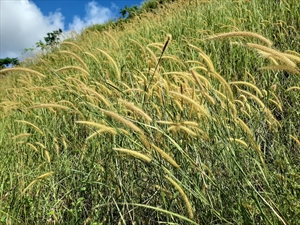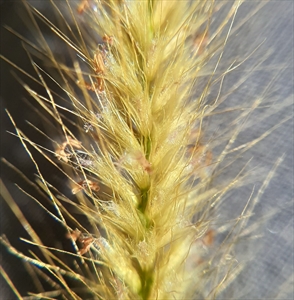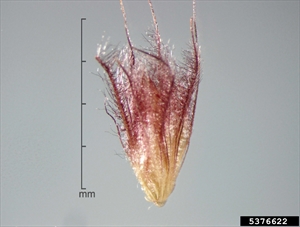Mission grass; it is also known as perennial mission grass, blue buffel grass, elephant grass.
Pacific Pests, Pathogens, Weeds & Pesticides - Online edition
Pacific Pests, Pathogens, Weeds & Pesticides
Mission grass (469)
Cenchrus polystachios. It was previous known as Pennisetum polystachion. Cenchrus polystachios is similar to Cenchrus pedicellatus which is an annual. It is a members of the Poaceae.
Asia, Africa, North, South and Central America, the Caribbean, Oceania. It is recorded from Australia, Federated States of Micronesia, Fiji, Guam, Kiribati, Marshall Islands, Northern Mariana Islands, Solomon Islands, and Vanuatu.
It is considered native to Asia and Africa, although some suggest it is native only to Africa.
An aggressive, perennial invasive grass of the tropics that competes with native species and crops in disturbed areas, and capable of forming large continuous expanses (Photos 1-4). Its invasiveness is due to the production of large numbers of seeds, and an ability to invade disturbed land in the fallow period after crop harvests. Also, where there are regular dry seasons, it remains green until late and this provides fuel for hotter fires later in the year. Growth is encouraged by repeated burning.
An upright perennial grass with slender, hairless stems, arising from the crown at the base of the plant, up to 3 m tall. Stems have 5-10 nodes (swellings where the leaves emerge), sometimes with roots. Leaves with leaf sheath partially enclosing the stem, and leaf blades, 5-45 cm long and 3-18 mm wide, hairless and smooth or somewhat hairy towards the base. There is a fringe of hairs where the leaf sheath meets the leaf blade (ligule), 1.5-2 mm long. Seedheads, 3-35 cm long and 6-26 mm across, erect or slightly drooping (Photos 3&4). They are mostly yellow with many densely packed, stalkless, flower spikelets, each 2-5 mm long, surrounded by numerous feathery bristles, 4-12 mm long (Photos 5-7). Mature seed and seedheads yellowish-brown. Seeds 3-5 mm long. surrounded by bristles.
Spread is by seed in wind, on vehicles, machinery, animals and in contaminated hay. It has been spread as an ornamental, a windbreak, and also as a pasture grass throughout the world. Mission grass has been widely introduced in Asia, Australia and Central and South America, both deliberately, as a potential forage plant, and accidentally.
Mission grass has been widely introduced in Asia, Australia and Central and South America, both deliberately, as a potential forage plant, and accidentally. In Fiji, Thailand and northern Australia, for example, it has spread into both agricultural and natural habitats, and along roadsides. There are instances of spread into national parks and nature reserves, where it has impacted diversity. The impact comes from the fuel load which accumulates. The above-ground parts die off each years, and this results in a high fuel load, which is often three to five times that of neighbouring areas free of mission grass, and results in more intense fires damaging to native species as well as crops and property. The extremely hot fires can cause the death of trees and transform natural savanna communities into exotic grasslands.
Used as a pasture species.
BIOSECURITY
The risk of introduction is high. Countries not yet infested should consider all likely pathways for entry, and apply quarantine measures accordingly. Particular attention should be given to the risks associated with the weed as a contaminant of pasture and other crop seed, and as an ornamental.
It is listed as a noxious weed in parts of the USA - prohibited plant that must be controlled - they serve no economic purpose and possess characteristics that are harmful to humans, animals or the environment.
BIOCONTROL
None reported.
CULTURAL CONTROL
- Physical & Mechanical:
- Hand weeding. Pull-up plants before release of seeds. Not an option for large stands because of the labour involved.
- Slashing. A slasher or mower is used to cut the grass at ground level. Effective at preventing flowering and seed formation, but needs to be done regularly, and at least three times a year to reduce seed production.
- Plough and harrowing. This is an option for pastures as long as it is followed by planting an alternative grass or a legume cover crop, e.g., Mucuna pruriens.
- Fire:
- Effective as long as if it is followed up with herbicide treatment, as fire can promote mission grass establishment.
- Hygiene:
- Treat vehicles and farm machinery. If moving from areas where the weed occurs to those weed-free, wash to remove soil. This is equally important if the machinery is being imported into a country or moved within a country.
- Fodder:
- Make sure hay brought into clean areas is free of mission grass.
CHEMICAL CONTROL
In Australia: glyphosate (and Fiji); imazapyr; imazapyr + glyphosate, are registered.
--------------------
Note, EU approval to use glyphosate ends in December 2022; its use after that date is under discussion. Note, imazapyr is not approved for use in the EU.
____________________
When using a pesticide, always wear protective clothing and follow the instructions on the product label, such as dosage, timing of application, and pre-harvest interval. Recommendations will vary with the crop and system of cultivation. Expert advice on the most appropriate herbicides to use should always be sought from local agricultural authorities.
AUTHORS Grahame Jackson, Aradhana Deesh & Mani Mua
Adapted from Cenchrus polystachios (L.) Morrone (2016) Weeds of Australia. Biosecurity Queensland Edition. Queensland Government, Identic, Lucid. (https://keyserver.lucidcentral.org/weeds/data/media/Html/cenchrus_polystachios.htm); and additional information from CABI (2019) Pennisetum polystachion (mission grass). Invasive Species Compendium. (https://www.cabi.org/isc/datasheet/39770); and Mission grass (2020) NT.GOV.AU. (https://nt.gov.au/environment/weeds/weeds-in-the-nt/A-Z-list-of-weeds-in-the-NT/mission-grass); and CHAH (2011) Cenchrus polystachios (L.) Morrone. WeedsAustralia - profiles. Department of Sustainability, Environment, Water, Population and Communities. (https://profiles.ala.org.au/opus/weeds-australia/profile/Cenchrus%20polystachios). and from Mission grass, perennial Cenchrus polystachios. Northern Territory Government. (https://territorystories.nt.gov.au/jspui/bitstream/10070/756043/1/Mission%20grass%20perennial%20factsheet.pdf). Photos 1,2,4,5 Forest and Kim Starr, Starr Environmental, bugwood.org. Photo 7 Julia Scher, Federal Noxious Weeds Disseminules, USDA APHIS PPQ, Bugwood.org.
Produced with support from the Australian Centre for International Agricultural Research under project HORT/2016/185: Responding to emerging pest and disease threats to horticulture in the Pacific islands, implemented by the University of Queensland, in association with the Pacific Community and Koronivia Research Station, Ministry of Agriculture, Fiji.










